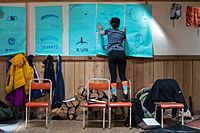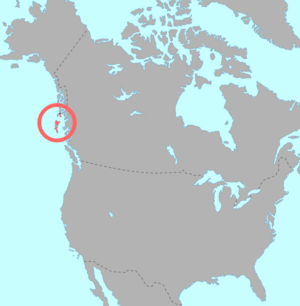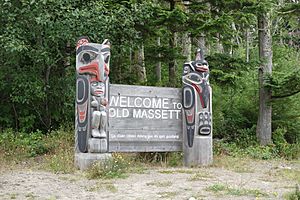Haida language facts for kids
Quick facts for kids Haida |
||||
|---|---|---|---|---|
| X̱aat Kíl, X̱aadas Kíl, X̱aayda Kil, Xaad kil | ||||

A woman hangs posters with the Haida words for various body parts
|
||||
| Native to | ||||
| Ethnicity | Haida people | |||
| Native speakers | Native: 13 (2018, 2020)e25 | |||
| Language family | ||||
| Writing system | Latin | |||
| Official status | ||||
| Official language in | ||||

Pre-contact distribution of Haida
|
||||

|
||||
|
||||
Haida is the special language of the Haida people. It is spoken in Haida Gwaii, a group of islands off the coast of Canada, and on Prince of Wales Island in Alaska.
Sadly, Haida is an endangered language. This means very few people speak it today. In 2022, there were only about 24 native speakers left. But don't worry, people are working hard to bring the language back!
Hundreds of years ago, around 1774, about 15,000 Haida people spoke the language. But then, diseases like smallpox arrived, and many Haida people died. This caused the number of speakers to drop a lot. Later, in residential schools, children were not allowed to speak Haida. This made even fewer people learn the language. Today, most Haida people speak English.
Some language experts think Haida is part of a bigger language family called Na-Dené. Others believe it's a language isolate, meaning it's not clearly related to any other language family. Haida has two main types, called dialects: Northern Haida and Southern Haida. They sound a bit different from each other. Northern Haida even has some very rare sounds called pharyngeal consonants.
The Haida language has special sounds like ejective consonants (sounds made with a burst of air) and different tones (how high or low your voice is when you say a word). These tones can change the meaning of a word! Haida also has many classifiers, which are like words that describe the type of object you're talking about.
Contents
History of the Haida Language
The Haida people first met Europeans in 1772. At that time, Haidas lived on Haida Gwaii, Dall Island, and Prince of Wales Island. About 15,000 Haida people lived there before Europeans arrived.
Soon after, a terrible smallpox disease hit, and the population dropped to about 10,000. Another disease in 1862 reduced the population even more, to just 1,658 people. By 1915, only 588 Haida people were left. Because of this, many villages combined into three main Haida villages: Masset, Skidegate, and Hydaburg.
Haida Jargon and Outside Influence
In the 1830s, a simple trade language called Haida Jargon was used. It mixed Haida words with English and other local languages. Later, when gold was discovered in 1858, Southern Haida people traveled to Victoria, British Columbia, to trade. They used another trade language called Chinook Jargon.
Meeting white settlers changed the Southern Haida people a lot. For example, by 1866, Skidegate Haida people were dressing in European clothes. But Northern Haida people still wore traditional bearskins and blankets ten years later.
Missionaries also came to Haida communities starting in 1876. At first, they used the Haida language. A missionary named John Henry Keen even translated parts of the Bible into Haida. But many Haida people, even in Masset, wanted services to be in English. Keen wrote in 1894 that he had to be very determined to keep using Haida in services.
Residential Schools and Language Decline
Around the early 1900s, Haida families started sending their children to residential schools. These schools strictly banned children from speaking their native languages. This rule played a big part in why many native languages, including Haida, almost disappeared.
By the 1930s, Haida families in Masset began speaking English to their children. Skidegate families were already doing this. They thought it would help their children do better in school. After this time, very few children grew up speaking Haida as their first language.
Current Status of Haida

Today, most Haida people do not speak the Haida language. UNESCO, an international organization, lists Haida as "critically endangered." This means it's in great danger of disappearing forever. Almost all the remaining speakers are elderly, usually over 70 years old. Even they often speak a simpler version of the language. People under 50 usually don't understand Haida very well. The language is rarely used, even among those who still speak it.
But there's hope! The Haida people are very interested in their traditional culture again. They are now paying for Haida language classes in schools in the three Haida communities. You can also take Haida classes at the University of Alaska Southeast in Juneau, Ketchikan, and Hydaburg. There's even a Haida language app for iPhones, which helps people learn words and phrases.
In 2017, a film company called Kingulliit Productions started making the first full-length movie spoken entirely in Haida. The actors had to learn how to say their lines correctly. The movie, called SGaawaay K’uuna (meaning "Edge of the Knife"), was released in 2019. This is a big step for keeping the language alive!
Haida Dialects
Haida has two main types, or dialects: Northern Haida and Southern Haida. Northern Haida is further divided into Alaskan (or Kaigani) Haida and Masset Haida. Southern Haida used to have Skidegate Haida and Ninstints Haida, but Ninstints Haida is now gone and we don't have much information about it.
The dialects mostly differ in how they sound and some words. But their grammar is almost the same. Northern Haida is special because it has pharyngeal consonants. These sounds are made deep in the throat and are very rare in languages around the world. They are also found in some nearby languages like Salishan and Wakashan languages.
How Haida Words Are Built
Haida words are often built by adding endings to them. For example, to say "the" with a noun, you add -aay to the end of the word. Some nouns, especially those from other languages, might use -gaay instead. There's also a special ending, -gyaa, which means "part of something" or "one or more items from a group."
Haida uses different pronouns (like "I," "you," "he") depending on how they are used in a sentence. There are separate pronouns for "I" and "we," and for "you" (one person) and "you" (many people). The third person pronoun ("he," "she," "it") is only used for living things.
Most nouns don't change to show if they are singular or plural. But some verbs do change to show if the subject is plural. Also, some family words have special forms when you are calling out to someone, like "grandfather!"
Instead of prepositions like "in" or "on," Haida often uses "relational nouns." These are nouns that describe where something is in time or space. For example, a word might mean "side facing away from the beach."
Haida Grammar and Sentence Structure
Haida sentences usually put the verb at the end. For example, instead of "I eat apples," it might be "Apples I eat." Haida also has a special rule called "direct-inverse" word order. This means the order of words can change depending on how "important" or "powerful" the subject and object are. For instance, a human is more "powerful" than a horse, and a horse is more "powerful" than a wagon.
Pronouns are often attached directly to the verb. Haida also has something called "obligatory possession." This means some nouns, like family words or body parts, cannot stand alone. They must always have a "possessor" attached to them. For example, you can say "my mother" but not just "mother" by itself.
Examples
Here are some common phrases in the Alaskan dialect of Haida:
| Kíl 'láa | Hello/ goodbye |
| Sán uu dáng G̱íidang | How do you do? |
| Díi 'láagang | I'm fine |
| Haw'áa | Thank you |
| Dáng díi Ḵuyáadang | I love you |
| Sán uu dáng kya'áang? | What's your name? |
| ... hín díi kya'áang | My name is ... |
| Háws dáng díi Ḵíngsaang | I'll see you again |
| Hingáan an hl gu Ḵuyáat-'uu | Just love one another |
| Gíistgaay gúust uu dáng Ḵ'wáalaagang? | Whose moiety do you belong to? |
See also
 In Spanish: Idioma haida para niños
In Spanish: Idioma haida para niños

